Last-Minute NYC Holiday Gift Guide 🎁
We’ve created a holiday gift guide with presents for the intrepid New Yorker that should arrive just in time—


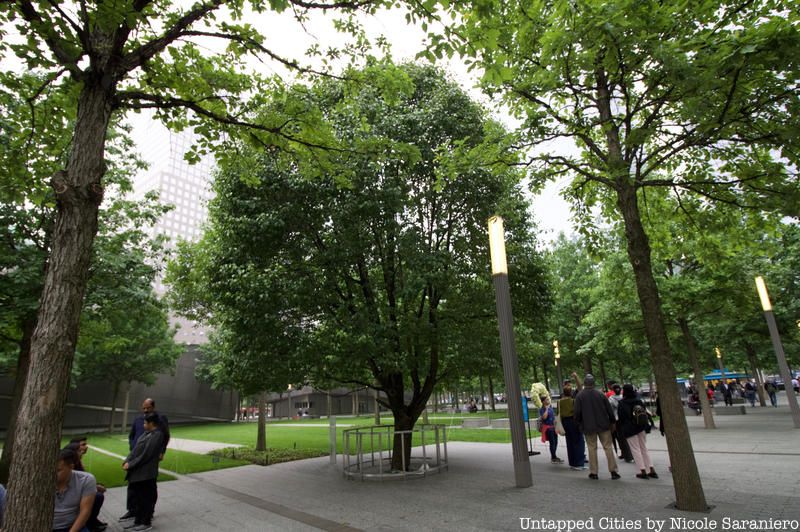
There are approximately 2.5 million trees growing throughout the parks and along the streets of New York City. However amongst them is a selection whose size, age, form or historical associations distinguish them from the rest. According to Benjamin Swett’s Great Trees of New York City: A Guide, published by the New York Tree Trust in 2000, trees tell the history of the city, letting us quite literally delve into the roots of New York. Here is a guide to a selection of such trees which tell of interesting anecdotes, historical or otherwise of the city. Unfortunately some have met their end but legends and stories around them still continue to linger.
1. Hare Krishna Tree in Tompkins Square Park
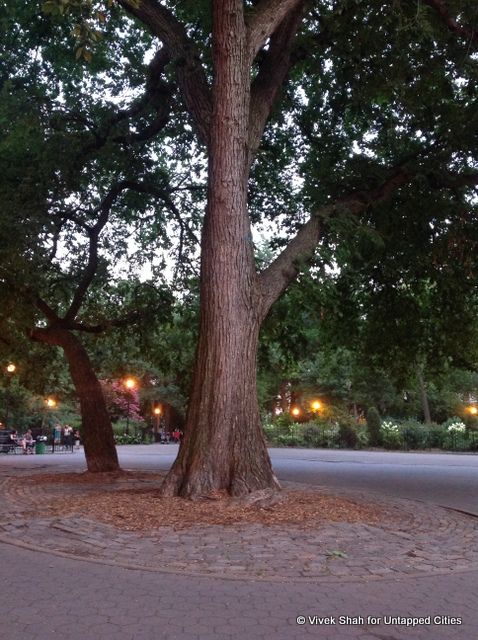
This historic American elm is of undetermined age but its great height and canopy coverage are indicative of its species. It dates back to the Park’s founding in 1873 and stands amidst a significant population of other mature elms which managed to survive the spread of Dutch Elm disease during the 1930s.
Beyond its remarkable age, the tree is a sacred site to followers of the Hare Krishna religious movement. On October 9th, 1966, it was here where the movement’s founder, A.C. Bhaktivedanta Swami Prabhupada, held the first outdoor chanting session of the Krishna mantra in the USA. Lasting over two hours, this was also the first time the chant was uttered outside of India. Prabhupada first arrived in New York in 1965 with little money but great ambitions. Staying in a rented storefront at 26 Second Avenue, he immediately undertook the task of gathering disciples.
Even after the swami’s death in 1977, adherents to Hare Krishna still continue to pay tribute to this site by leaving garlands and other such tokens of appreciation around the tree.
2. Hangman’s Elm in Washington Square Park
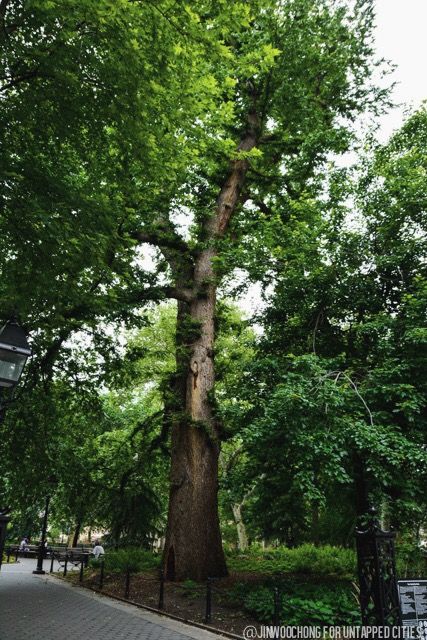
Despite being the oldest tree in Manhattan, the Hangman’s Elm is actually an English elm, located in the northwest corner of Washington Square Park. English elms were amongst the first non-native arboreal species planted in the continent. The oldest specimens can be found in the original English settlements in the north-east, predominantly around Boston.
Historical records suggest that the elm has seen about 330 years of American history. Believed to have been a seedling in 1679, its existence would have very closely followed the British conquering of “New Netherland”, later renamed “New York”.
There are several eponymous legends surrounding the elm. During the Revolutionary War, it was said that traitors were hung from the tree. In fact, in 1824, the Marquis de Lafayette even claimed to witness the hanging of twenty highwaymen there. Historical records also shed light on how much of the area making up the park was once a potter’s field, a place of burial for slaves and victims of yellow fever alike. Alternatively another story goes that in 1820 a nearby gallows was set up to hang Rose Butler, a slave convicted of arson. Whichever tale holds true, the dark aura of the Hangman’s Elm’s past nevertheless has aptly led to its rather gruesome naming.
3. Madison Tree in Madison Square Park
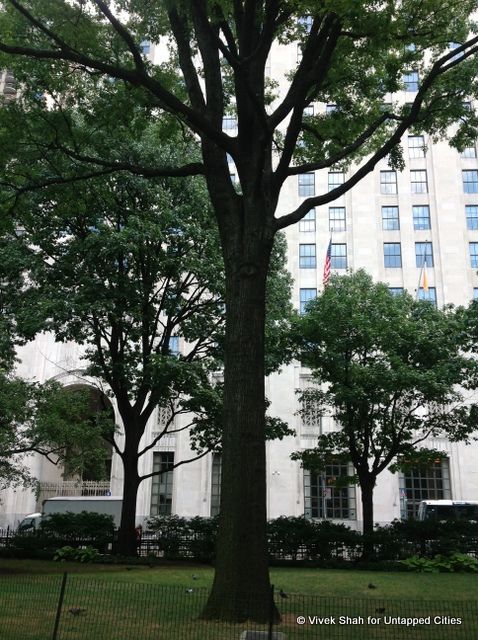
The Madison Tree is a tree from the Virginia estate of former president, James Madison. It was planted in the east side of the Park in 1936 to commemorate the centennial of the opening of Madison Avenue.
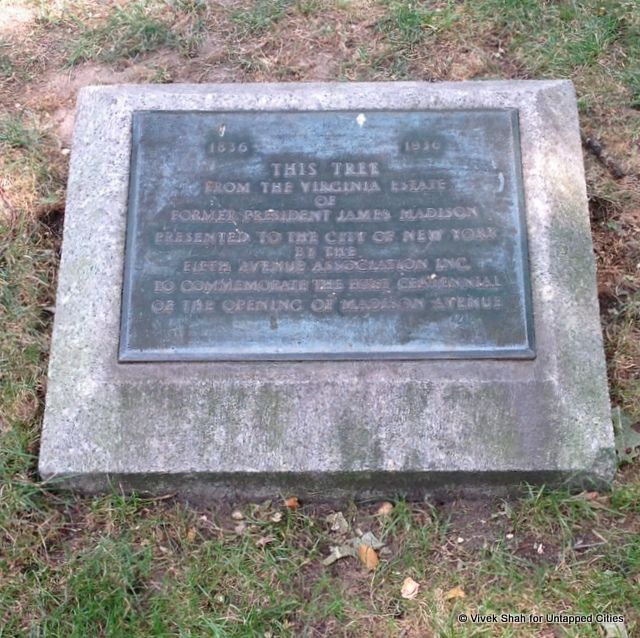
4. Mulberry tree in Shakespeare Garden, Central Park (blown down in 2006)

Photo by Instagrammer ysvsynphotos from our Untapped Cities/East River Ferry contest
For years a legend persisted that the mulberry tree in the Shakespeare Garden was a graft from one Shakespeare had planted himself in New Place, Stratford-upon-Avon in 1602. The Central Park Conservancy maintained this story, adding that King James I sent Shakespeare the cutting to try and introduce the silk culture into England. However after the tree blew down in 2006, ring count analyses revealed that the tree in the Shakespeare Garden was only eighty-five years old. Although Shakespeare’s original mulberry tree outlived him, it certainly died in the mid-1700s, well before this tree. As a result it rendered the legend rather fictional.
5. Stuyvesant Pear Tree on the corner of 13th Street and Third Avenue (knocked down in 1867)
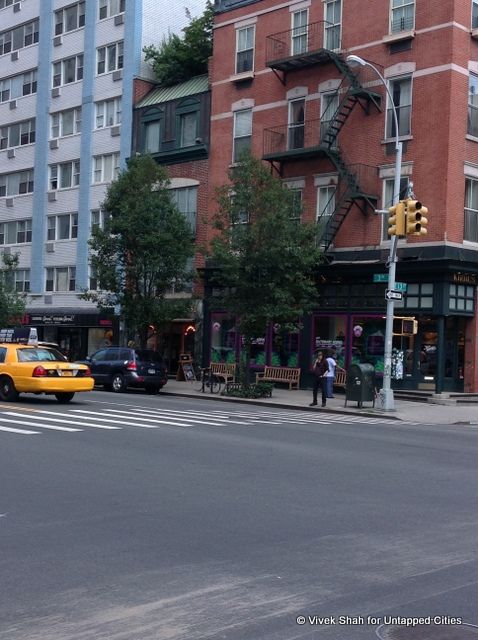
In 1674, Peter Stuyvesant, the Dutch colonial governor, planted this pear tree in his Bouwerie or farm. It stood here for two hundred years and as the tree grew, so did New York City with 13th Street and Third Avenue appearing around it. The tree remained there until February 1867, when it was first weakened by a massive winter storm and then after two drays (wagons) collided. One was thrown against the tree with such great force that it managed to bring it down.
All that is left on the street-corner is a plaque marking the Stuyvesant tree’s spot. However a Stuyvesant descendant did give a cross-section of the original trunk to the New-York Historical Society.
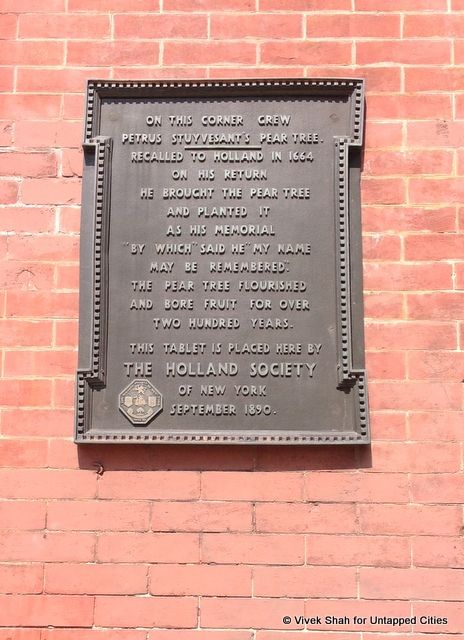

6. Survivor Tree in Memorial Plaza at the World Trade Center

A Callery pear tree, dubbed Survivor Tree, somehow miraculously survived the terrorist attacks of September 11th, blossoming at GRound Zero on the first day of spring. It was discovered amongst the smoldering rubble, albeit in a weakened state. Workers, however, managed to free it and nurse it back to health in a Bronx park before replanting it again in Memorial Plaza. Survivor Tree, now standing at about thirty feet, approximately four times its original height back in 2001, easily towers over the other trees planted in the plaza.
The tree’s resilience holds great sentimental value in New York City. Mayor Bloomberg himself explained that the tree is a testament to the city’s ability to endure the worst, standing as a beacon for a brighter future.
7. Buttonwood Tree on Broad Street, to the left of the New York Stock Exchange main entrance.
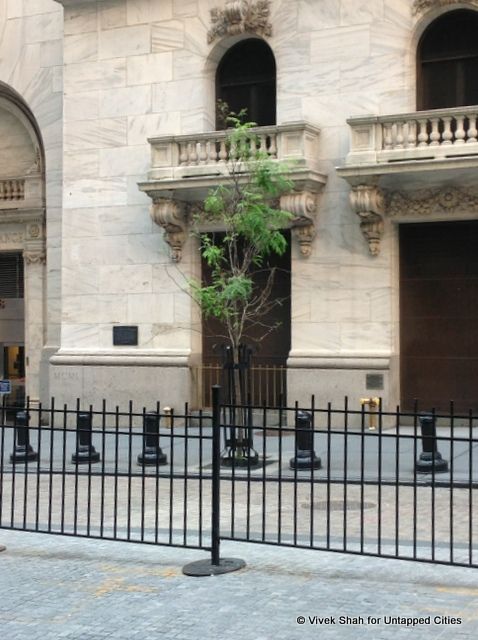
Little more than a tiny sycamore planted in the sidewalk, the Buttonwood Tree stands in stark contrast to the enormous American flag and Roman façade of the imposing New York Stock Exchange (NYSE) building behind it. For years, it has been trying to outgrow its hole in the concrete but to no avail. Nevertheless, despite its short stature, the tree symbolises the very formation of the NYSE; behind it is a plaque which reads “central market place beneath for purchase and sale of securities was founded in 1792 by merchants who met daily beneath a buttonwood tree that grew nearby.” This group of merchants was formalized by the “Buttonwood Agreement” although they did not really become financially active until after the War of 1812.
Interestingly enough, when traders have been at the Stock Exchange for twenty-five years, they are immediately invited to join a group called the Buttonwood Club. Although there are no official privileges, members are entitled to bragging rights and a numbered pin which can be worn on the vest.
For more information about the famous trees throughout New York, check out the New York Tree Trust’s publication, Great Trees of New York City: A Guide. It is also worth visiting Benjamin Swett’s website.
Subscribe to our newsletter